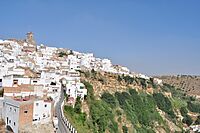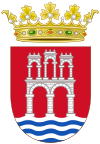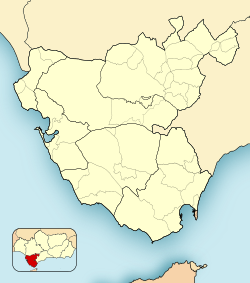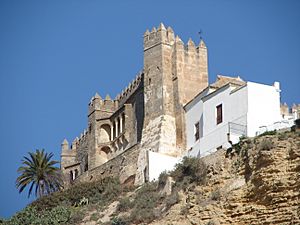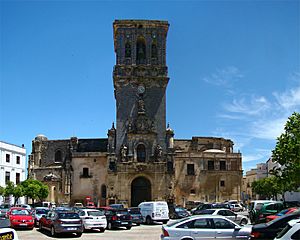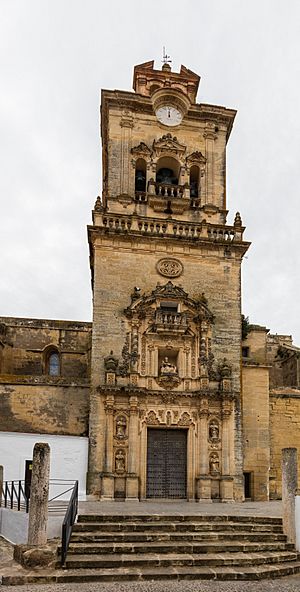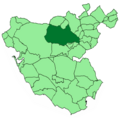Arcos de la Frontera facts for kids
Quick facts for kids
Arcos de la Frontera
|
|||||||||||||||
|---|---|---|---|---|---|---|---|---|---|---|---|---|---|---|---|
|
|||||||||||||||
 |
|||||||||||||||
| Country | |||||||||||||||
| Autonomous community | |||||||||||||||
| Province | |||||||||||||||
| Comarca | Sierra de Cádiz | ||||||||||||||
| Municipality | Arcos de la Frontera | ||||||||||||||
| Area | |||||||||||||||
| • Total | 527.54 km2 (203.68 sq mi) | ||||||||||||||
| Elevation | 185 m (607 ft) | ||||||||||||||
| Population
(2018)
|
|||||||||||||||
| • Total | 30,741 | ||||||||||||||
| • Density | 58.2724/km2 (150.925/sq mi) | ||||||||||||||
| Demonyms | Arcense, Arcobricense | ||||||||||||||
| Time zone | UTC+1 (CET) | ||||||||||||||
| • Summer (DST) | UTC+2 (CEST) | ||||||||||||||
| Postal code |
11630
|
||||||||||||||
|
|||||||||||||||
Arcos de la Frontera is a beautiful town and municipality in the province of Cádiz, in Andalusia, Spain. It sits high up on a sandstone ridge, with the Guadalete river flowing around three of its sides. From the town, you can see amazing views of the river valley and the peak of San Cristóbal. The town got its name because it was a "frontier" (border) during Spain's battles with the Moors in the 13th century.
Contents
History of Arcos de la Frontera
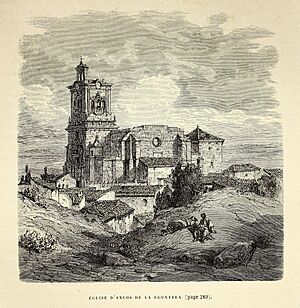
People have lived in this area for a very long time. There is evidence that Stone Age cave-dwellers used rocks to build homes. You can also find Roman ruins nearby.
Arcos became an independent Moorish kingdom, called a taifa, in 1011. This happened when the big Umayyad Caliphate of Córdoba started to fall apart. Later, in 1091, the Almoravid dynasty took over the region. For a short time from 1145 to 1147, Arcos was a taifa again, connected to Granada.
The town became a strong Christian area after King Alfonso X of Castile, also known as 'the Wise', took it back from the Moors between 1252 and 1284. He built a Gothic cathedral that still stands on the high ridge today.
Arcos is famous for its ten bells. These bells rang out during the wars with the Moors. Several Moorish flags were captured in a battle near Zahara. These flags have been proudly displayed in a church in Arcos since 1483.
Main Sights to Explore
Historic Castles and Churches
- Castillo de Arcos (11th–15th century castle): This is a medieval castle that was originally built by the Moors. It was mostly rebuilt in the early 15th century. Today, it is private property, so you can't visit inside. The castle has a square shape with four towers at its corners.
- Basílica Menor de Santa María de la Asunción: This church was built after the Christians took back the area. It stands on the site of an old Visigoth temple and a 13th-century mosque. The main front of the church has a beautiful Plateresque-Gothic style. Its tower was fixed after a big earthquake in 1755. This church has been a protected historic monument since 1931.
- Iglesia de San Pedro: This church was built between the 15th and 17th centuries. It stands where a 14th-century fortress or watchtower used to be. You can see different styles like Gothic, Renaissance, and Baroque in its tower and front.
- Iglesia de San Agustín: This church was started in 1539 as a convent. It was later used by the Order of St. Augustine. After some changes in Spain, the convent was left empty, but the church building still remains.
- Iglesia de San Miguel: This building was once a Moorish fortress. In the 15th century, it became a small church. It was rebuilt in the 18th century and also served as a home for orphaned girls. Now, it's used for art shows and talks.
- Iglesia de San Francisco: This church was built between the 16th and 17th centuries.
- Convento de la Encarnación: This convent was founded in the early 16th century. Its main entrance has a Plateresque style, and the door next to it is late-Gothic. Today, it's used as a parish hall.
- Capilla de la Misericordia: This chapel was started in 1490 to help abandoned children and provide a home and hospital for women. Its front is Gothic. Now, it's a place for conferences and exhibitions.
- Convento de las Mercedarias Descalzas: This is the only convent in Arcos where nuns still live in cloister. It dates back to 1642. The nuns here make delicious sweets that are sold in the convent and local candy shops.
Other Interesting Places
- Palacio de los Condes del Águila: This is a 15th-century palace with a mix of late Gothic and Mudéjar styles.
- Palacio del Mayorazgo: This house-palace was built in the 17th century. It is now a building used by the town government.
- Edificio del Pósito: This stone building from 1738 was once a wheat storage house in the 18th century. Later, it became a public school. Today, it is a health center.
- Historic Center: The old part of Arcos was declared a Historic-Artistic Monument in 1962. It's a great place to walk around and see old buildings.
- Remains of the Roman and Moorish City Walls: You can still see parts of the old city walls, even though many sections are ruined or gone. These walls protected the upper part of the city. One of the old city gates, Puerta de Matrera, is still partly preserved.
Unique Streets and Features
- Calle Nueva: This street used to be the moat around the castle. After an earthquake in 1755, a wall collapsed, filling the moat and creating this street. It's decorated with flower pots.
- Roman Altar: You can find an old Roman altar in the alley called Callejón de las Monjas.
- Guardacantones: These are old columns used to protect the corners of buildings on narrow streets. You'll see them often in Arcos.
- Callejón de las Monjas: This alley has special supports called flying buttresses that cross over it. They were built in 1699 to hold up the walls of the church.
- Plaza del Cabildo: This is a main square in Arcos. On one side is the church of Santa María, on another is the Parador (a special hotel), and on another is the Ducal Castle. There's also a famous viewpoint here called "Mirador de la Peña" where you can see the countryside.
- Calle Maldonado: This is one of the most painted streets in Arcos by artists.
- Calle Cuna: This narrow street got its name because it was the entrance to a shelter for children who had been abandoned.
- Ventanas con Orejeras: These are special windows with small holes on the sides, like "earmuffs." They let people see what's happening outside from inside their homes.
- Plaza de Toros de Arcos de la Frontera: This is the town's bullring.
Traditional Farmhouses and Mills
Many traditional large farmhouses, called cortijos and haciendas, are found around Arcos. Many of these old buildings are now used as hotels. There are also several old mills.
- Cortijo de San Rafael
- Cortijo de la Fuensanta
- Cortijo Casablanca
- Hacienda el Santiscal
- Molino del Bachiller Viejo (mill)
Natural Wonders
- The Cliffs and "La Peña": The town is famous for its towering vertical cliffs and the promontory (high point) called "la Peña."
- The Guadalete River and Reservoir: This river flows around the town, and there's a reservoir nearby.
Delicious Local Food
Arcos de la Frontera has many tasty local dishes.
- Main Dishes:
- Sausages
- Ajo a la molinera (a type of garlic soup)
- Sopa de Clausura (a special soup)
- Gazpacho serrano (a cold soup)
- Sopa de espárragos (asparagus soup)
- Berza (a chickpea stew)
- Dishes made with game meat, pork, and lamb.
- Sweets:
- Bollos de Semana Santa (Easter buns)
- Pestiños (fried pastries with honey)
- Sweets made by the nuns at the Convento de las Mercedarias Descalzas.
You can find many places to eat in the historic center, like 'Bar la Cárcel' and 'Mesón La Rebotica', which are great for tapas.
Fun Festivals and Fiestas
Arcos de la Frontera celebrates many exciting festivals throughout the year.
- Festividad de Nuestra Señora de las Nieves: This is the feast day for the town's Patron Saint, Our Lady of the Snows.
- Semana Santa de Arcos (Holy Week of Arcos): This is a very important religious festival in April, known for its processions. It has been declared a National Tourist Interest.
- Toro del Aleluya (Bull of the Hallelujah): This is a traditional running of the bulls event held every Easter Sunday. It started in 1784.
- Zambombas of Arcos: These are traditional Christmas carols and celebrations, recognized for their cultural importance.
- Día del Caballo (Day of the Horse): A special day dedicated to horses.
- Carnaval de Arcos (Carnival of Arcos): A lively carnival celebration held every February.
- Cruz de Mayo (May Cross): A festival celebrating crosses in May.
- Belén Viviente (Living Bethlehem): A special event where people act out the Christmas story, declared a Tourist Interest of Andalusia.
- Romería del Santísimo Cristo del Romeral (Pilgrimage of the Holy Christ of El Romeral): A religious pilgrimage held every September.
Other Towns in the Municipality
The municipality of Arcos de la Frontera includes several smaller towns and villages:
- La Perdiz
- Los Barrancos
- El Santiscal
- Jédula
- La Sierpe
- Pequeña Holanda
See also
 In Spanish: Arcos de la Frontera para niños
In Spanish: Arcos de la Frontera para niños
Images for kids


